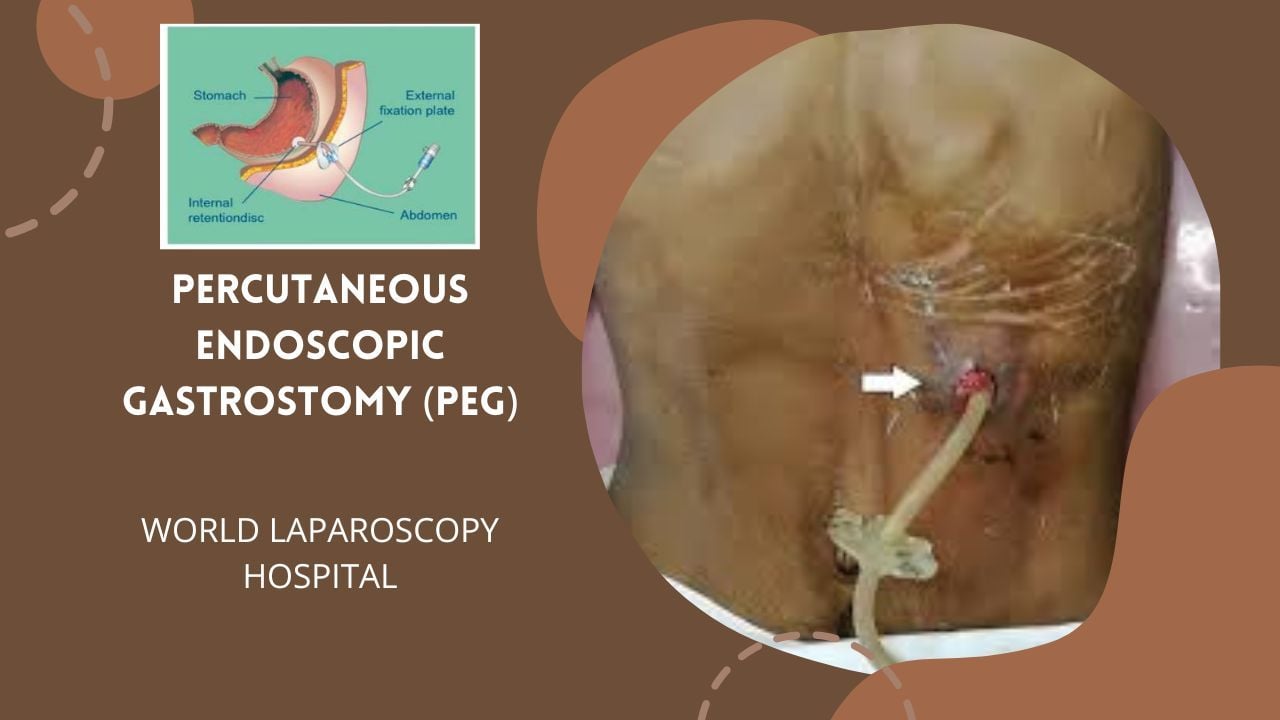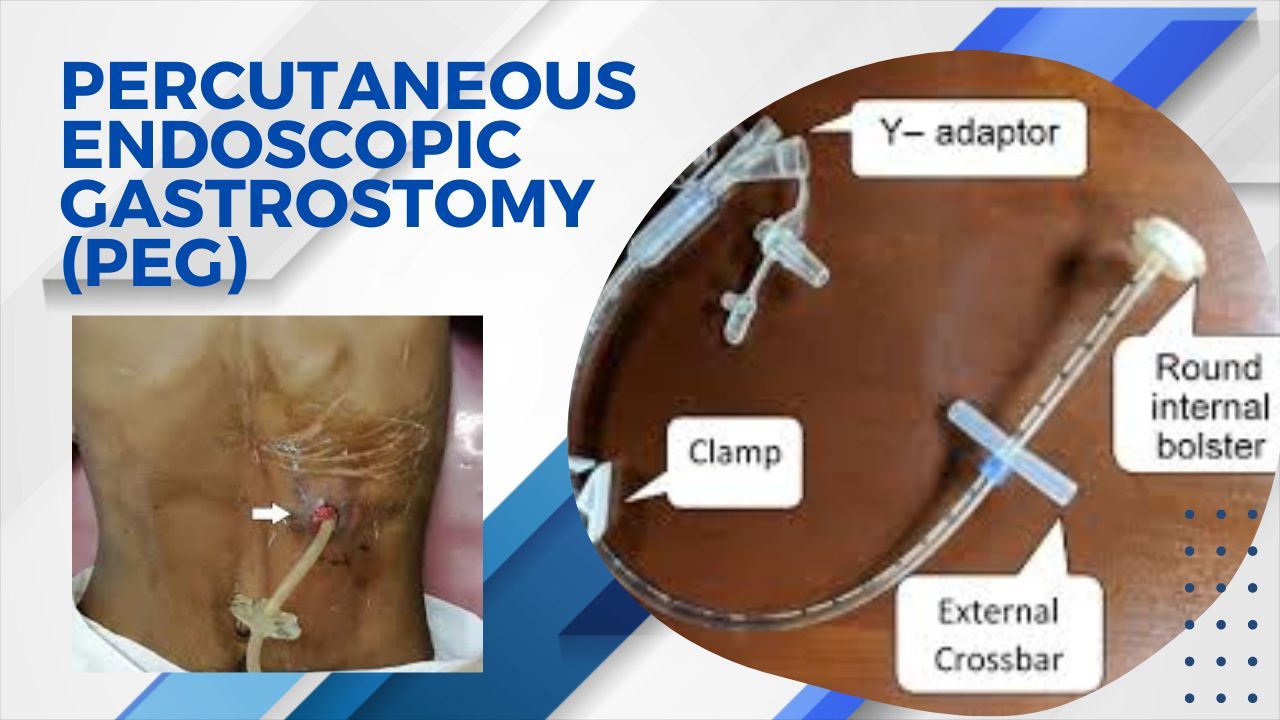The PEG procedure involves the use of an endoscope, which is a flexible tube with a light and camera on one end. The patient is usually given a sedative and a local anesthetic to minimize discomfort. The endoscope is inserted through the mouth, down the esophagus, and into the stomach. Using the camera for guidance, a small incision is made on the abdomen, and a special feeding tube is passed through the incision and into the stomach. The tube has a retention balloon or a bumper at the internal end to keep it securely in place.

After the procedure, the external portion of the tube remains outside the body, and it can be used to administer liquid food, medications, or fluids directly into the stomach. The PEG tube can also be used for drainage, if necessary, to remove stomach contents.
PEG tubes are commonly used in cases where long-term enteral feeding is required, such as in patients with swallowing difficulties due to neurological conditions, head and neck cancers, or other medical conditions that affect the ability to eat or drink normally. They provide a safe and effective way to deliver necessary nutrition and fluids while reducing the risk of aspiration pneumonia or malnutrition.
The care and maintenance of PEG tubes are crucial to prevent complications such as infection or blockage. Proper cleaning, flushing, and regular check-ups by healthcare professionals are necessary to ensure the tube functions correctly and remains in good condition.
It's important to consult with a healthcare professional for more specific information regarding the indications, benefits, risks, and post-procedural care associated with PEG placement.
-
Getting ready: Before the procedure, the doctor will explain everything to you and your parents. They will ask you not to eat or drink anything for a little while before the procedure. You will also be given some medicine to make you feel relaxed and a special numbing cream or liquid to make the area where the tube will go numb.
-
Magic camera: You will lie down on a special table, and the doctor will gently put a long, bendy tube called an endoscope into your mouth. The endoscope has a tiny camera and a light at the end, like a magic eye! This helps the doctor see what's going on inside your body.
-
Going down: The doctor will carefully slide the endoscope down your throat and into your stomach. It might feel a bit strange, like swallowing a big gulp of air, but it shouldn't hurt.
-
Tiny cut: Once the endoscope is in your stomach, the doctor will make a very small cut, like a tiny hole, on your tummy. They will clean the area really well before making the cut. Don't worry, you won't feel a thing because the numbing cream or liquid will do its job.
-
Special tube time: Through the little cut, the doctor will gently put a special tube into your stomach. This tube is called a feeding tube, and it will help you get the food and medicine you need. The doctor will make sure the tube is in the right place inside your stomach.
-
Staying in place: The doctor will make sure the tube doesn't come out by securing it to your tummy with a special bandage or a small device. This will help keep the tube in the right spot and prevent it from moving around.
-
All done: Once the tube is safely in your stomach, the doctor will take out the endoscope. You might feel a little bit bloated or full, but that feeling will go away soon.
After the procedure, the nurses will keep an eye on you for a little while to make sure everything is okay. They will teach you and your parents how to take care of the feeding tube, like cleaning it and flushing it regularly. They will also show you how to use the tube to get your food and medicine.

Remember, if you have any questions or worries, you can always talk to your parents or the doctors and nurses. They are there to help you and make sure you feel better.
While percutaneous endoscopic gastrostomy (PEG) is generally considered a safe procedure, there can be potential complications that may arise. Here are some possible complications:
-
Infection: There is a risk of infection at the site where the tube is inserted. Proper cleaning and care of the PEG site can help reduce this risk, but occasionally, infections can still occur.
-
Tube dislodgement: The PEG tube may accidentally come out or get pulled out, which can require reinsertion or replacement. It's important to be cautious and follow the guidelines for securing and handling the tube to minimize the risk of dislodgement.
-
Peristomal leakage: Leakage of stomach contents around the PEG site can happen in some cases. It can cause skin irritation or infection. Proper cleaning and appropriate dressing can help prevent this complication.
-
Gastrointestinal complications: Some individuals may experience complications related to the gastrointestinal tract, such as bloating, cramping, diarrhea, or constipation. These issues can be managed with dietary adjustments or medications.
-
Bleeding: There is a small risk of bleeding during the PEG procedure or from the PEG site afterward. Most cases are minor and resolve on their own, but severe bleeding may require medical attention.
-
Aspiration pneumonia: If the PEG tube is not positioned properly, there is a risk of food or liquids entering the lungs instead of the stomach, leading to aspiration pneumonia. Regular monitoring and correct tube placement can help prevent this complication.
-
Discomfort or pain: Some individuals may experience temporary discomfort or pain at the PEG site or in the abdomen after the procedure. This can usually be managed with over-the-counter pain relievers or as advised by a healthcare professional.
It's important to note that the occurrence of complications can vary depending on individual factors, underlying health conditions, and adherence to proper care instructions. It's always recommended to discuss potential complications and concerns with a healthcare professional before undergoing the PEG procedure. They can provide personalized guidance and address any specific risks or precautions relevant to your situation.
To reverse a percutaneous endoscopic gastrostomy (PEG), a medical professional needs to perform a procedure to remove the PEG tube. Here is a general overview of the process:
-
Preparation: Before the reversal procedure, you will typically undergo a medical evaluation to assess your overall health and determine the appropriate approach for PEG removal.
-
Tube removal: During the reversal procedure, a healthcare professional will first clean the area around the PEG site to maintain sterility. They will then gently remove the external portion of the tube, carefully detaching any securing devices or dressings.
-
Internal tube removal: After removing the external portion, the healthcare professional will determine the method for removing the internal portion of the PEG tube. There are two common methods:
a. Simple traction: In some cases, the internal tube can be gently pulled out with a slow and steady motion. This method is only suitable when the internal bumper or balloon has deflated or dissolved, allowing for safe removal without causing injury.
b. Endoscopic removal: If the internal tube cannot be removed through simple traction, an endoscope may be used to assist in the process. The endoscope is inserted through the mouth, down the esophagus, and into the stomach. Using the endoscope, the healthcare professional can locate and safely remove the internal tube.
-
Post-procedure care: After the PEG tube is removed, the healthcare professional will clean and dress the PEG site as needed. They may provide instructions on wound care, including keeping the area clean and monitoring for any signs of infection or complications.
It's important to note that the decision to reverse a PEG tube should be made in consultation with a healthcare professional. They will evaluate your specific medical condition and needs to determine if PEG removal is appropriate and discuss any potential alternatives or considerations.
There are several alternatives to percutaneous endoscopic gastrostomy (PEG) that can be considered depending on the specific needs and circumstances of the individual. Here are a few common alternatives:
-
Nasogastric tube (NG tube): A nasogastric tube is a temporary feeding tube that is inserted through the nose and down into the stomach. It can be used for short-term nutritional support or medication administration. NG tubes are typically used when feeding is required for a relatively short duration, such as after surgery or during a temporary illness.
-
Orogastric tube: Similar to an NG tube, an orogastric tube is inserted through the mouth and into the stomach. It can also be used for short-term feeding, particularly in cases where the nasal passage is blocked or inaccessible.
-
Jejunostomy tube: A jejunostomy tube is inserted directly into the jejunum, which is a part of the small intestine, bypassing the stomach altogether. This type of tube is typically used when there is a specific medical condition or surgical requirement that prevents the use of the stomach for feeding. Jejunostomy tubes are often used for long-term enteral feeding.
-
Total parenteral nutrition (TPN): TPN is a method of providing nutrition directly into the bloodstream through a catheter inserted into a vein. It is used when the digestive system cannot adequately absorb nutrients from the gastrointestinal tract. TPN is typically reserved for individuals who cannot tolerate or benefit from enteral feeding methods.
-
Oral supplementation: In some cases, oral supplements or modified diets may be recommended to enhance nutrition when swallowing difficulties are present but do not require the use of a feeding tube. These approaches involve altering the texture or consistency of food and beverages to make them easier to swallow and provide adequate nutrition.
It's important to note that the selection of an alternative to PEG depends on the specific medical condition, individual needs, and recommendations from healthcare professionals. Each alternative has its own benefits, limitations, and considerations. The decision should be made in consultation with a healthcare team to determine the most suitable option for the individual's circumstances.
| Older Post | Home | Newer Post |

